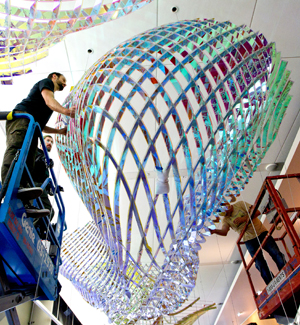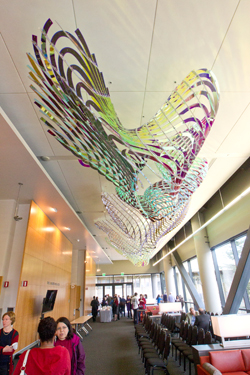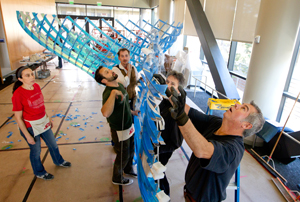May 20, 2013 - By Rosanne Spector
New sculpture to be dedicated to former dean Philip Pizzo
How do you portray space?
One possible answer now hangs from the ceiling of the Li Ka Shing Center for Learning and Knowledge. The new sculpture, artist Alyson Shotz's vision of the skeletal structure of emptiness, was commissioned by the School of Medicine to honor former dean Philip Pizzo, MD. It will be dedicated May 21.
Sailing above the Yang and Yamazaki Lobby on the second floor of the center, the glimmering, undulating lattice appears lightweight and ephemeral — like a scaffold made of dragonfly wings. In reality, it weighs more than 3,000 pounds. The 56-foot-long sculpture, titled Three Fold, is actually made of curved aluminum slats covered on both sides with dichroic-acrylic-coated plastic. Though the acrylic is clear, it both reflects and refracts, resulting in a spectrum of iridescent colors that change with the angle and quality of the ambient light.
"It is of course an honor to be associated with the work of Alyson Shotz, and it is humbling to have her work dedicated to my contributions as dean," Pizzo said. "I am also deeply humbled by the generosity of the many faculty and of the Li Ka Shing Foundation for their contributions that allowed the commission and creation of this incredible work for Stanford Medicine.
"Art, science and medicine are interconnected in so many important ways. The extraordinary work of Alyson Shotz takes these connections to a deeper level since it is based on scientific precision and principles of physics, chemistry and engineering."
The concept of the sculpture was inspired by a CAT scan, Shotz said. "I was very interested to learn that CAT scans image by sections, using a penetrating wave. This seems quite relevant, as my work represents an imaging of space, and the wave illuminating the shape, in this case, is color: the varying wavelengths of light that the viewer will see reflecting off the sculpture," she wrote in her proposal.

Workers install Three Fold, which hangs from the ceiling of the second floor of the Li Ka Shing Center for Learning and Knowledge. The sculpture, by artist Alyson Shotz, wiil be dedicated May 21.
The result is an artwork that will become a destination for anyone interested in contemporary art, said Cantor Arts Center curator Hilarie Faberman, PhD. "Alyson Shotz is a widely respected artist and has had many important commissions. This will be another 'go-to' piece for Stanford — like the Chihuly and Andy Goldsworthy's Stone River."
"This is the biggest project she's done to date," said Sabrina Buell, a Stanford alumna who serves on the medical school's art committee. "To have it at Stanford is a very special thing."
Shotz's work is exhibited at some of the world's most prestigious art museums, including the Solomon R. Guggenheim Museum, in New York, The Hirshhorn Museum and Sculpture Garden, The Whitney Museum of American Art and the San Francisco Museum of Modern Art. Her upcoming solo exhibitions are scheduled for, among other venues, the Edythe and Eli Broad Museum in East Lansing, Mich., and the Wellin Museum in Clinton, NY.
The medical school's art committee chose Shotz for the installation in October 2011 after considering slides of works by about a dozen highly respected artists from around the world selected by Buell, an art adviser at the San Francisco firm Zlot Buell + Associates.
"It was unanimous. No second choice. We all loved her," said Ralph Greco, MD, the committee's chairman and a professor of surgery. The Li Ka Shing Foundation, five medical school departments and more than a dozen medical school faculty and their partners helped fund the acquisition of the piece, its installation and associated construction.
The committee members were also unanimous in the decision to dedicate the artwork to Pizzo, who stepped down last fall after 12 years as dean. "It made sense — because of his strong support of art at the medical school, and to recognize his tenure as dean," Greco said. Pizzo created the art committee in 2011, which not only commissions works but organizes rotating exhibits featuring art created by members of the medical school's community. The current exhibit of four artists' work, also in the Li Ka Shing Center, will continue through the summer.

Three Fold hangs above the Yang and Yamazaki Lobby.
"A reminder of the beauty of science, Alyson Shotz's Three Fold is stunning sculpture and a fitting tribute to Phil Pizzo's dynamic and visionary leadership," said Lloyd Minor, MD, dean of the School of Medicine.
Upon receiving the offer to submit a proposal, the Brooklyn-based artist quickly came to Stanford to examine the space. She then returned to her studio to develop her concept, flew back to Stanford for its presentation, which the committee also loved, and then returned to Brooklyn to complete the job.
Like much of Shotz's work, Three Fold was born on a computer. "I could not have made or even visualized the sculpture without the computer," Shotz said. "Three-D modeling allows me to go to a level of geometric detail that would be impossible otherwise. When I first began, I saw that on the computer I could make complicated folded shapes in digital space viewable from all angles that were virtual sculptures but were also like drawings — they start as lines on a grid. I then wanted to make those drawings into real physical sculptures."
After deciding on the sculpture's form, Shotz worked with a computer programmer to figure out how hundreds of pieces of aluminum would fit together like a puzzle to make the model a reality. Shotz took this information to a fabricator — DCM Fabrication in Brooklyn — where the aluminum and acrylic were cut and the pieces assembled into sections that together form the three parts making up the sculpture.
The sections were loaded into a 53-foot tractor-trailer and hauled across the country, arriving at Stanford in January 2013. Shotz and a team of art-installation specialists worked for two weeks assembling the sections, peeling the protective film off the sculpture's surfaces, mounting the sculpture on cables and raising it into position.

Shotz, far left, oversees assembly of the sculpture, which weighs more than 3,000 pounds.
Shotz named the sculpture when the installation was nearly complete, as is often the case for her. She chose Three Fold in part, she said, because each of the sculpture's three parts began as the same shape, which she folded and stretched in different ways to create the three distinct forms. She likes the title's open-ended meaning: "It implies three folds as well as an experience three times greater. It also implies that each of the three parts multiply each other — or are more than themselves."
Shotz has an abiding fascination with science. As a college student at the University of Colorado, she initially studied glaciology before switching to art. So it's no wonder that she gravitates toward scientific imagery, with much of her work attempting to visualize invisible forces like space and gravity.
The sculpture's abstract form allows viewers to imbue it with their own meanings. Some see it as the frame of a boat, or a skeleton, perhaps of a dinosaur or a whale. Others say that it brings to mind the twisting form of DNA's double helix.
To art adviser Buell, Three Fold evokes scientific imagery. "Scientists use lines in a similar way to show different dimensions or maps or particles interacting," she said.
For Pizzo, it speaks to his former work as dean. "I always strove to view each member of our Stanford community as a unique and shining member of a unique and interconnected mission, in some ways analogous to how each component of Three Fold connects to create something larger than itself," he said.
More generally, he said, its evanescent imagery compels us to view it differently each time we encounter it, "reminding us of the importance of being receptive to new insights and opportunities."
About Stanford Medicine
Stanford Medicine is an integrated academic health system comprising the Stanford School of Medicine and adult and pediatric health care delivery systems. Together, they harness the full potential of biomedicine through collaborative research, education and clinical care for patients. For more information, please visit med.stanford.edu.